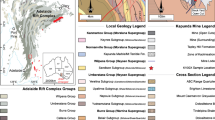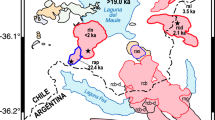Abstract
The study shows the nature of the fluid inclusions analyses in tectonically induced gold-quartz veins in northwestern Nevada, U.S.A. and compares the results of fluid inclusions with those of other gold deposits of similar environments in the world. The quartz veins are present in low-grade regionally metamorphosed rocks, and form clusters of prospects along a north-trending regional shear zone. These deposits and prospects are hosted by Mesozoic metasedimentary, metavolcanic, and deformed igneous rocks along thrusts, faults, folds, and shear zones. The gold-quartz veins are present in three major tectonostratigraphic terranes: the Triassic Koipato and Star Peak Groups, Middle Triassic Jungo terrane, and mid-Paleozoic to Jurassic Black Rock terrane. In general, the three major tectonostratigraphic units have been involved in polyphase deformation. Fluid inclusions in vein quartz in northwestern Nevada, U.S.A. show that mineralizing fluids are water-rich, CO2−H2O fluids with low-salinity (3–5wt% NaCl eq.). Homogenization temperatures range from 190 to 300°C, mostly 250–300°C in median values. All fluid inclusion samples contain variable amounts of liquid and gases CO2 with 30 to 50 volume percent of liquid and vapor ratio. Fluid densities estimated from CO2-bearing fluid inclusions range from 0.5 to 0.85 g/cm3 and do not show significant differences between clusters throughout northwestern Nevada. The results of fluid inclusion geobarometry indicate that the gold-quartz veins formed at depths, ranging from 5.0 to 10.5 km, which corresponds to brittle-ductile deformational regimes. Consistent fluid chemistry and characteristics of fluid inclusions also indicate the fluids were from relatively homogeneous single source of origin released during the Cretaceous time.
Similar content being viewed by others
References
Bodnar, R.J., Binns, P.R. and Hall, D.L., 1989, Synthetic fluid inclusion VI. Quantitative evaluation of the decrepitation behavior of fluid inclusions in quartz at one atmosphere confining pressure. Journal of Metamorphic Geology, 7, 229–242.
Bohlke, J.F.P., 1982, Orogenic (metamorphic-hosted) gold-quartz veins. U.S. Geological Survey Open-File Report 82–795, p. 70–76.
Bohlke, J.K. and Kistler, R.W., 1986, Rb−Sr, K−Ar and stable isotope evidence of the ages and sources of fluid components of gold-bearing quartz veins in the northern Sierra Nevada foothills, metamorphic belt, California, Economic Geology, 81, 296–322.
Bozzo, A.T., Chen, H-S., Kass, J.R. and Barduhn, A.J., 1975, The properties of the hydrates of chlorine and carbon dioxide. Desalination, 16, 303–320.
Brown, P.E. and Lamb, W.M., 1989, P-V-T properties of fluids in the system H2O±CO2±NaCl: New graphical presentations and implications for fluid inclusion studies. Geochimica et Cosmochimica Acta, 53, 1209–1221.
Chen, H-S., 1972, The thermodynamics and composition of carbon dioxide hydrate. M.S. thesis, Syracuse University Syracuse, 67 p.
Cheong, S., 1999, Structural setting and fluid characteristics of metamorphic gold-quartz veins in northwest Nevada. Ph.D. thesis, University of Nevada, Reno, 332 p.
Cheong, S., Peters, S.G., and Iriondo, A., 2000, Summary of structural setting and fluid characteristics of low-sulfide Au-quartz veins in northwestern Nevada. In: Cluer, J.K., Price, J.G., Struhsacker, E.M., Hardyman, R.F. and Morris, C.L. (eds.), Geology and Ore Deposits 2000: The Great Basin and Beyond. Geological Society of Nevada Symposium Proceedings, May 15–18, p. 473–506
Collins, P.L.F., 1979, Gas hydrates in CO2-bearing fluid inclusions and the use of freezing data for estimation of salinity. Economic Geology, 74, 1435–1444.
Compton, R.R., 1960, Contact metamorphism in Santa Rosa Range, Nevada. Geological Society of America Bulletin, 71, 1383–1416.
Diamond, L.W., 1992, Stability of CO2 clathrate hydrate+CO2 liquid +CO2 vapour+aqueous KCl-NaCl solutions: Experimental determination and application to salinity estimates of fluid inclusions. Geochimica et Cosmochimica Acta, 56, 273–280.
Doebrich, J.L., 1996, Resource assessment of the Bureau of Land Managements Winnemucca district and Surprise Resource area, northwest Nevada and California-Geology, and its relation to resource genesis. U.S. Geological Survey Open-File Report 96-30, 33 p.
Elison, M.W. and Speed, R.C., 1989, Structural development during flysch basin collapse: the Fencemaker allochthon, East Range, Nevada. Journal of Structural Geology, 11, 523–538.
Fayek, M. and Kyser, T.K., 1995, Characteristics of auriferous and barren fluids associated with the Proterozoic contact Lake Lode Gold Deposit, Saskatchewan, Canada. Economic Geology, 90, 385–406.
Field, M.P., Kerrich, R. and Kyser, T.K., 1998, Characteristics of barren quartz veins in the Proterozoic La Ronge Domain, Saskatchewan, Canada: a comparison with auriferous counterparts. Economic Geology 93, 602–616.
Fyfe, W.S. and Kerrich, R., 1984, Gold: Natural concentration processes. In: Foster, R.P. (ed.), Gold 82: The geology, geochemistry and genesis of gold deposits. Proceedings of the Symposium Gold 82, University of Zimbabwe, p. 99–127.
Goldfarb, R.J., Leach, D.L., Rose, S.C. and Landis, G.P., 1989, Fluid inclusion geochemistry of gold-bearing quartz veins of the Juneau gold belt, southeastern Alaska: Implications for ore genesis. In: Keays, R.R., Ramsay, W.R.H. and Groves, D.I. (eds.). The geol ogy of gold deposits: The perspective in 1988. Economic Geology Monograph, 6, p. 363–375.
Goldfarb, R.J., Phillips, G.N. and Nokleberg, W.J., 1998, Tectonic setting of synorogenic gold deposits of the Pacific Rim. Ore Geology Reviews, 13, 185–218.
Goldstein, R.H. and Reynolds, T.J., 1994, Systematics of fluid inclusions in diagenetic Minerals. SEPM short course 31, 199 p.
Groves, D.I., Goldfarb, R.J., Gebre-Mariam, M., Hagemann and Robert, F., 1998, Drogenic gold deposits: A proposed classification in the context of their crustal distribution and relationship to other gold deposits types. Ore Geology Reviews, 13, 727.
Ho, S.E., 1987, Fluid inclusions: their potential as an exploration tool for Archaean Deposits. In: Ho, S.E. and Groves, D.I. (eds.), Recent advances in understanding Precambrian gold deposits. Department of Geology and University Extension, University of Western Australia, Publication, 11, 239–263.
Hollister, L.S. and Crawford, M.L., 1981, Short course in fluid inclusions: Applications to Petrology. Mineralogical Association of Canada short Course Handbook, 6, 304 p.
Hurai, V., 1992, Immiscibility in the system H2O−CO2−NaCl: Applications to fluid inclusion thermobarometry. Neues Jahrbuch fur Mineralogie, Abhandlungen, 1, 5–17.
Jacobs, G.K. and Kerrick, D.M., 1981, Methane: an equation of state with application to the ternary system H2O−CO2−CH4. Geochimica et Cosmochimica Acta, 45, 607–614.
Kalyuzhnyi, V.A. and Koltun, L.I., 1953, Some data on pressures and temperatures during formation of minerals in Nagol’nyy Kryazh, Donets Basin, Mineral. Sb. Lvov Geol. Obshch, Vol. 7, 67–74.
Kerrich, R., 1989, Geodynamic setting and hydraulic regimes: shear zone hosted mesothermal gold deposits. In: Bursnall, J.T. (ed.), Mineralization and shear zones. Geological Association of Canada Short Course Notes, 6, 89–128.
Landefeld, L.A., 1988, The geology of the Mother Lode Belt, Sierra Nevada Foothills metamorphic belt, California. In: Krivarsanyi, G. and Grant, S.K. (eds.), Tectonic control of ore deposits and the vertical and horizontal extent of ore systems. North American Conference, University of Missouri-Rolla, Rolla, Missouri, p. 47–56.
Maher, K.A., 1989, Geology of the Jackson Mountains, northwest Nevada. Ph.D. thesis, California Institute of Technology, Los Angeles, California, 491 p.
McCuaig, T.C. and Kerrich, R., 1994, P-T-t-deformation-fluid characteristics of lode gold deposits: Evidence from alteration systematics. In: Lentz, D.R. (ed.), Alteration and alteration processes associated with ore-forming systems. Geological Association of Canada Short Course Notes, 11, 339–379.
Miller, L.D., Goldfarb, R.J., Gehrels, G.E. and Snee, L.W., 1994, Geologic links among fluid cycling, vein formation, regional deformation, and plutonism in the Juneau gold belt, southeastern Alaska. Geology, 22, 203–206.
MRDS, 1995, National Mineral Resources Data System. U.S. Geological Survey computer data base, Office of Mineral Resources, Reston, VA (Available through Mineral Information Office, Reno, Nevada, Mackay School of Mines).
Oldow, J.S., 1984, Evolution of a late Mesozoic back-are fold and thrust belt, northwestern Great Basin, U.S.A.. Tectonophysics, 12, 245–274.
Peters, S.G., 1993, Formation of oreshoots in mesothermal gold-quartz vein deposits: examples from Queensland, Australia. In: Haynes S.J. (ed.), Vein-type Ore Deposits. Ore Geology Reviews, 8, 277–301.
Potter, R.W., Clynne, M.A. and Brown, D.L., 1978, Freezing point depression of aqueous sodium chloride solution. Economic Geology, 73, 284–285.
Quinn, E.L. and Jones, C.L., 1936, Carbon dioxide. American Chemical Society Monograph 72, Rheinhold Publishing Cooperation, New York, 294 p.
Robbins, C.H., 1985, Geology of Lantern property near the Scossa mining district, Pershing County, Nevada. M.S. thesis, University of Nevada, Reno, 89 p.
Robert, F., Boullier, A.M. and Firdaous, K., 1995, Gold-quartz veins in metamorphic terranes and their bearing on the role of fluids in faulting. Journal of Geophysical Research, 100, 12861–12879.
Roedder, E., 1963, Studies of fluid inclusions II: Freezing data and their interpretation. Economic Geology, 58, 167–211.
Roedder, E., 1984, Fluid inclusions. Mineralogical Society of America, Reviews in Mineralogy, 12, 644 p.
Roedder, E. and Bodnar, R.J., 1980, Geologic pressure determinations from fluid inclusion studies. Annual Review of Earth and Planetary Sciences, 8, 263–301.
Sibson, R.H., 1986, Earthquake and rock deformation in crustal fault zones. Annual Review of Earth and Planetary Sciences, 14, 149–175.
Sibson, R.H., Robert, F. and Poulsen, K.H., 1988, High-angle reverse faults, fluid-pressure cycling, and mesothermal gold-quartz deposits. Geology, 16, 551–555.
Silberling, N.J., 1991, Allochthonous Terranes of Western Nevada, Current Status. In: Raines, G.L., Lisle, R.E., Schafer, R.W. and Wilkinson, W.H. (eds.), Geology and Ore Deposits of the Great Basin Symposium Proceedings. Geological Society of Nevada, Reno, Nevada, p. 101–102.
Silberling, N.J., Jones, D.L., Blake, M.C. and Howell, G., 1987, Lithotectonic terrane map of the western conterminous United States (1∶2,500,000). U.S. Geological Survey Miscellaneous Field Studies Map, Map MF-1874-C, 20 p.
Speed, R.C., 1978, Basinal terrane of the Early Mesozoic marine province of the western Great Basin. In: Howell, D.G. and McDougall, K.A. (eds.), Mesozoic Paleogeography of the Western United States. Pacific Coast Paleogeography Symposium 2, p. 237–252.
Swanenberg, H.E.C., 1979, Phase equilibria in carbonic system, and their application to freezing studies of fluid inclusions. Contributions to Mineralogy and Petrology, 68, 303–306.
Todheid, K. and Franck, E.U., 1963, Das Zweiphasengabiet und die kritische Kurve in system Kohlendioxid-Wasser bis zu Drucken von 3500 bar. Zeitschrift fuer Physikalische Chemie, 37, 388–401.
Vikre, P.G., 1981, Silver mineralization in the Rochester district, Pershing County, Nevada. Economic Geology, 76, 580–609.
Werre, R.W., Jr., Bodnar, R.J., Bethke, P.M. and Barton, P.B., Jr., 1979, A novel gas-flow fluid inclusion heating/freezing stage. Geological Society of America Abstract with Programs, 11, p. 539.
Weir, R.H. and Kerrick, D.M., 1987, Mineralogic, fluid inclusion, and stable isotope studies of several gold mines in the Mother Lode, Tuolumne and Mariposa Counties, California. Economic Geology, 82, 328–344.
Wyld, S.J., 1990, Paleozoic and Mesozoic rocks of the Pine Forest Range, northwestern Nevada, and their relation to volcanic arc assemblages of the western U.S. Cordillera. Geological Society of America, Special Paper 255, 219–237.
Wyld, S.J., 1996, Early Jurassic deformation in the Pine Forest Range, northwest Nevada, and implications for Cordilleran tectonics. Tectonics, 15, 566–583.
Author information
Authors and Affiliations
Corresponding author
Rights and permissions
About this article
Cite this article
Cheong, S. Fluid inclusion study of metamorphic gold-quartz veins in northwestern Nevada, U.S.A.: Characteristics of tectonically induced fluid. Geosci J 6, 103–115 (2002). https://doi.org/10.1007/BF03028281
Received:
Accepted:
Issue Date:
DOI: https://doi.org/10.1007/BF03028281




